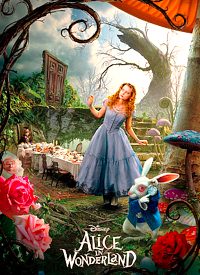
Director Tim Burton’s Alice in Wonderland boasts an impressive $116 million at the North American box office this opening weekend. Burton’s film is an entertaining mélange of Lewis Carroll’s Through the Looking-Glass and Alice’s Adventures in Wonderland, often shortened to Alice in Wonderland. Much like Carroll’s works, the film is enjoyed by children and adults alike, though the violence and dark undertones of Burton’s film may force parents to look elsewhere when choosing a family film for the young ones.
While there are various similarities between the film and the original story, Burton’s film is not the Alice in Wonderland to which we have grown accustomed. Set 13 years after Alice (Mia Wasikowska) has made her way home from Wonderland, she finds herself once again trapped in a world of etiquette and social rules that she still struggles to understand. She refuses to wear a corset or stockings, believing that in doing so, she adheres to the social standards imposed on women in the Victorian era. As an adult, Alice no longer remembers her adventures in Wonderland, but recalls vividly the excursions in recurring “dreams.” When a young lord named Hamish proposes to her, Alice becomes distracted by a white rabbit that crosses her path. Though Alice is confused by her attraction to the rabbit, she succumbs to her curiosity and follows the rabbit down his borough, and plunges back into the world of Wonderland.
Reunited with some old friends, most notably the smoking blue caterpillar (Alan Rickman), the Mad Hatter (Johnny Depp), the dormouse (Barbara Windsor), the March Hare (Paul Whitehouse), and the Cheshire cat (Stephen Fry), Alice is confused by much of what transpires. Confusion morphs into fear when Alice learns that she has been prophesized to defeat the evil Red Queen and restore the rightful White Queen to her throne.
Despite the differences between the novel and the movie, Burton remains true to the primary elements of Carroll’s works while adding a new depth to some of the characters. The Mad Hatter is not simply a nutty character, but a man with a past. The Red Queen, while despicable, is three-dimensional at times, particularly when she gives serious consideration to the famous Machiavellian question that asks whether it is better to be feared or loved.
It is debatable whether the Alice on the cusp of adulthood is more relatable than the young Alice whose fascination allows her to be enveloped by the madness of Wonderland. The beauty of Lewis Carroll’s Alice’s Adventures in Wonderland is witnessing a naive young child struggle to understand the adult world. While in Carroll’s Wonderland, Alice witnesses incomprehensible and often arbitrary behavior, and in the process, learns to understand the adult world a bit more. By the end of the original story, Alice has somewhat transformed into an adult, losing most of her imaginative abilities, rendering it impossible for her to remain in wonderland. The primary conflict in the Alice’s Adventures in Wonderland is internal.
This is in stark contrast to Burton’s Alice in Wonderland, which focuses on the external conflict of deposing the Red Queen who is guilty of usurping the crown from her sister, the White Queen. The storyline is reminiscent of the historic struggle between Queen Elizabeth and Bloody Mary, and even mirrors the relationship of the wicked witches of the East and West in The Wizard of Oz. What’s regrettable is that in changing the focus from the internal to the external, Burton discards most of the hilariously clever dialogue and pun usage evident in Carroll’s story.
While Burton’s film abandons Carroll’s coming of age theme, it remains true to the motif of identity, which Burton’s Alice discovers by the end of the film. In both the original story and Burton’s film, Alice is asked to identify herself by everyone she meets, and is even told that she is not the “same Alice” that entered Wonderland previously. This of course confuses Alice, who believed that her experience in wonderland was in fact a dream. Nevertheless, when Alice is accused of losing her “muchness,” she is inspired to find her identity yet again, and does it in a very grand way.
Burton’s Alice in Wonderland is aesthetically pleasing from beginning to the end. The visual effects suffice in holding the moviegoers attention during the few times the film becomes slow. Overall, it was a pleasant movie experience and recommended for anyone who enjoys fantasy films.




